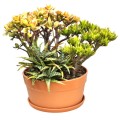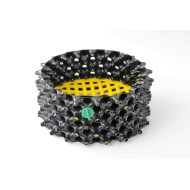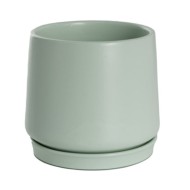











- Stock: In Stock
- Model: yam-nagaimo-50mm-tube
Family: Dioscoreaceae (includes several yam species)
Genus: Dioscorea (includes several yam species)
Botanical/Binomial Name: Dioscorea polystachya
Meaning of Name:
Dioscorea, after the Ancient Greek physician, pharmacologist, botanist and author Pedánios Dioskourídēs (Πεδάνιος Διοσκουρίδης), c. 40–90 AD; and
polystachya, from Ancient Greek πολύς (polús, ‘many’) + Ancient Greek στάχυς (stákhūs, ‘ear of wheat’, ‘scion, progeny’): a reference to the aerial tubers?
Common Names: Chinese Yam, Mountain Yam, Nagaimo, Cinnamon Vine, Cinnamon Yam
Botanical Characteristics: Herbaceous | Perennial | Deciduous | Tuberous | Frost hardy
Propagation: Aerial Tubers
Item Description:
Dimensions of the tube are 50 mm square × 120 mm deep. These tubes produce beautifully straight and deep roots, which gives these young plants every advantage once planted out.
Plants may vary in length anywhere between those from photos 1 to 3.
Plant Description:
This yam species is also called the cinnamon yam or cinnamon vine on account of the cinnamon-scented flowers!
This is a perennial vine which dies down in winter. It can reach 3 m high and 1.5 m wide if allowed to grow vertically as with runner beans, or it can be trained into a small bush.
This plant is NOT suitable for pots owing to the large tubers, which can grow up to 1 m long after 6-12 months.
A popular yam in Asia for its large edible tubers with excellent storage. Tubers can be harvested in autumn as the leaves die back, or left in the ground to harvest as required through winter.
The vine additionally produces aerial bulbils (also called tubercles) along the stem, which look like small new potatoes and which can also be eaten like potatoes (fried, boiled, mashed, in stews). These are harvested in summer and autumn.
Growing Information:
This is a very easy-care plant but a vigorous grower, and will need maintenance to keep it under control, as it will readily grow to 3 m. It prefers rich, well-drained soils in part shade.
The tuber can be harvested in winter once the leaves die back. People traditionally cut off only enough tuber as needed, leaving the rest to store in the soil until required again.
The aerial tubers can be harvested for consumption at any time, or planted over winter for new plants to emerge the following late spring.
Local pick-up is welcome — we’re in Gwynneville, near Wollongong University.
Pick-up is by mutual arrangement please, as we don’t have a shopfront.
Having said that, we are always here and more often than not can easily fit in with whichever day and time suits you best!
Feel free to suggest preferred pick-up time(s) in the comments box during checkout and we’ll reply as soon as we see the notification.
Especial Note Regarding Large Air-Pot® Orders
Depending on the order, we may suggest that large Air-Pot® orders are best sent directly to you from the warehouse.
Especial Note Regarding Jujube Trees
When posting out bare-rooted jujube trees, we routinely trim them to fit the box and keep postage costs to a minimum. These trees are typically knee-high when planted out, though some may be smaller.
This of course doesn’t apply for pick-ups, and in fact we will set aside the tallest trees specifically for this purpose. These trees can often be hip-high, and sometimes taller again.
Please note that this is not a guarantee, as heights of different cultivars can differ from year to year.

































